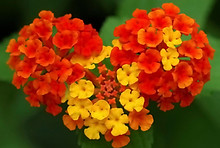LANDTECH
SEPTEMBER
PLANT SPOTLIGHT
OLEANDER

Oleander shrubs are so adaptable to our desert soil conditions that they are virtually indestructible! Luckily, they are also beautiful. They have long, slender leaves, with trumpet-shaped flowers in multiple colors such as white, fuschia, and soft pink. Oleanders will flower multiple times each year, brightening up your landscape even in the hottest months. There are multiple varieties of oleanders, allowing it to be trained as a small shrub, hedge, wall, or small tree. With versatility like this, there is always a good spot for an oleander!
FUN FACT! The Oleander was the first plant to grow after the atomic bombing of Hiroshima during WWII.

HOLIDAYS
AVERAGE TEMPS
LABOR DAY
FIRST DAY OF FALL
HIGH 100
LOW 75

WEEDS
The combination of recent monsoon rains and higher temperatures makes September an ideal month for weeds to pop up. To combat these, you’ll need to apply post-emergent herbicides. There are two types of herbicides: contact and systemic.
Contact herbicides only kill the plant parts that are contacted. Systemic herbicides are absorbed by the roots or foliage and spread throughout the plant. If you choose systemic herbicides, be careful not to misapply the chemical to plants, grass, and shrubs you don’t want to kill!
PLANTS
The September landscape is full of the soft, bright colors of Lantana, Ruellia and Yellow Bells in bloom. Towards the end of the month, once all the blooms have expired, we will start shaping most plants to create a nice manicured look through the winter.



TREES
The strong winds and heavy rains of the summer monsoons are done for this year. Slightly loosen tree stakes so trees can begin building important fibers that will help them grow stronger and eventually stand on their own. Trees left staked too long can be left damaged, weak and unable to support themselves.
IRRIGATION
Summer isn’t officially over just yet, but we will start to see temperatures dropping. This is also a perfect opportunity to run through your irrigation clock programs and make sure everything is working properly before over seeding in October.


GRASS : PREPARING FOR OVERSEEDING
In September, the summer bermuda grass is preparing to go dormant for the winter. Reducing water and lowering mow heights will help encourage the dormancy cycle. Having the bermuda grass in a strong, healthy state of dormancy will give the winter ryegrass the best conditions to grow in thick and green all winter.
-
Approximately 1 month before seeding cut your watering schedule back by 40%
-
Approximately 2-3 weeks before seeding, turn off the water to the grass. We recommend the sprinklers run 2 days per week for only 1 minute. This will keep your irrigation system lubricated and help with the dust when mowing.

SMART IRRIGATION
Here in the southwest, we are used to managing sprinklers and drip irrigation with an irrigation clock or timer. These clocks are manually programmed and adjusted by your landscaper. The days, time, and duration is determined by the conditions and the type of plant(s) being watered. While this is certainly more preferable than hand watering your landscape with a garden house, there are still major inefficiencies.

The most obvious issue with a typical irrigation system is the inability to quickly and remotely adjust the watering schedule. This means if there is a rainstorm, your sprinklers and other irrigation components will still turn on, as scheduled. Instead of taking advantage of the free water falling from the sky, you are still paying to water your grass, trees, and shrubs through your irrigation system. This wastes money, water, and could potentially damage your plants from over-watering.
Another issue is changes in the landscape. Watering schedules may have been setup when plants were new and fragile, but never changed once they became mature and established. Over time the plants themselves may have been removed or replaced with something entirely different, with different water needs. For example: a patch of grass that was installed 10 years ago but was been converted to a bed for seasonal flowers. If the irrigation components and clock were not also converted, there will be major water waste and inefficiencies.

Smart irrigation systems customize watering schedules & run times to meet specific landscape needs by monitoring weather, soil conditions, evaporation & plant water use to automatically adjust the watering schedule to actual conditions of the site.

These conditions are determined using weather stations placed locally on-site. As outdoor temperatures fluctuate, or rainfall increases, smart irrigation controllers consider on site-specific variables, such as soil type, sprinklers’ application rate, etc. to adjust the watering run times or schedules. Smart irrigation systems are able to make these adjustments automatically, or allow your landscape professional to remotely alter watering schedules.Smart irrigation systems and controllers versus traditional irrigation controllers conserve water across a variety of scenarios and water usage reviews indicate water savings anywhere from 30 to 50 percent! Reports and data about past and current conditions can be accessed 24/7 by your landscaper via websites and apps. Properties of all sizes, ages, and plant pallets can benefit from smart irrigation!
Smart irrigation systems and controllers versus traditional irrigation controllers conserve water across a variety of scenarios and water usage reviews indicate water savings anywhere from 30 to 50 percent! Reports and data about past and current conditions can be accessed 24/7 by your landscaper via websites and apps. Properties of all sizes, ages, and plant pallets can benefit from smart irrigation!
